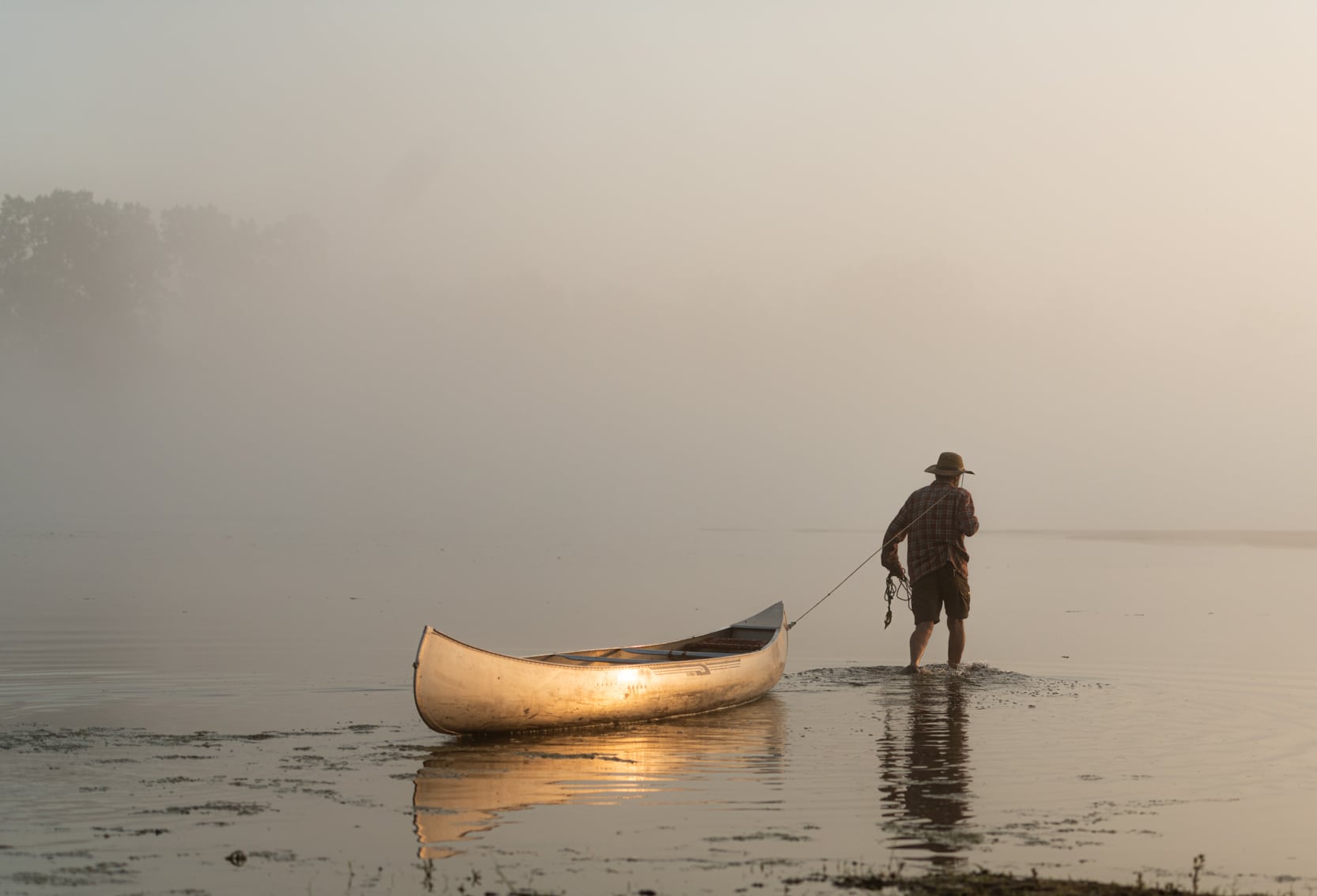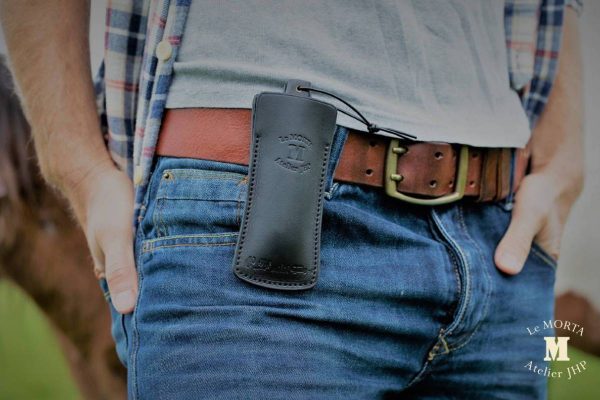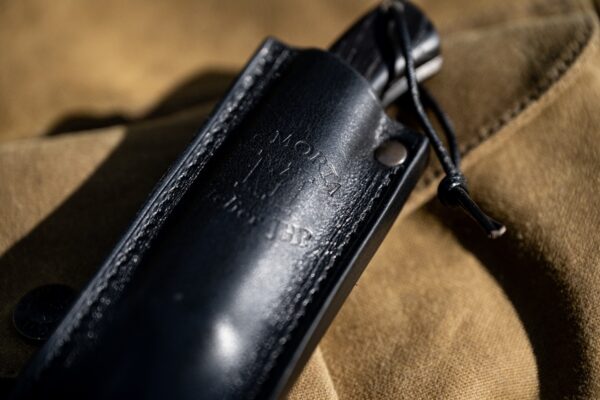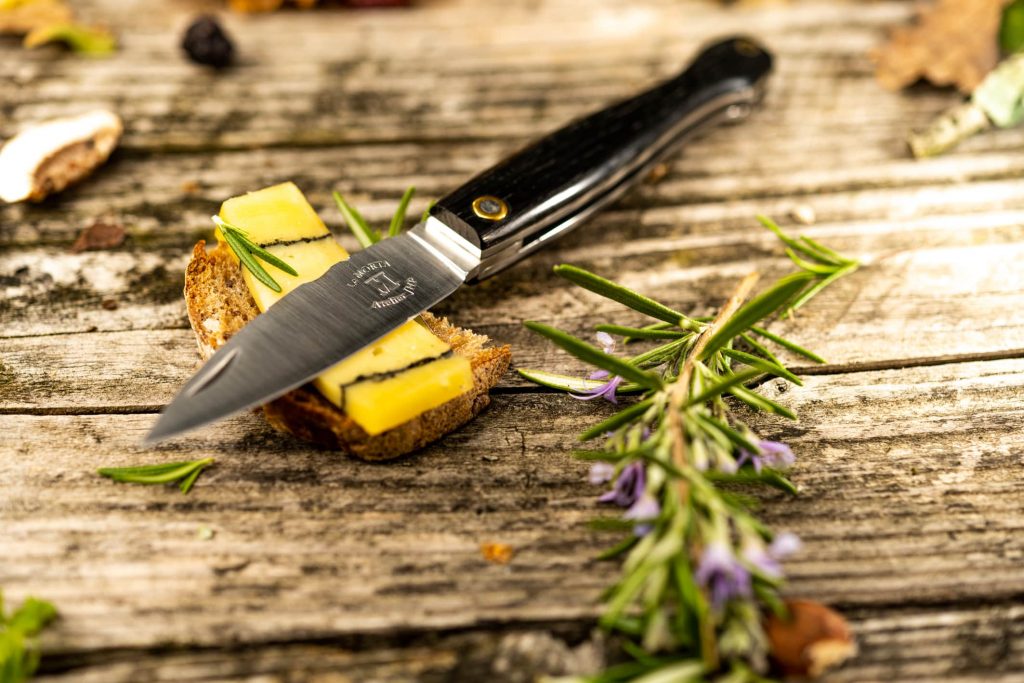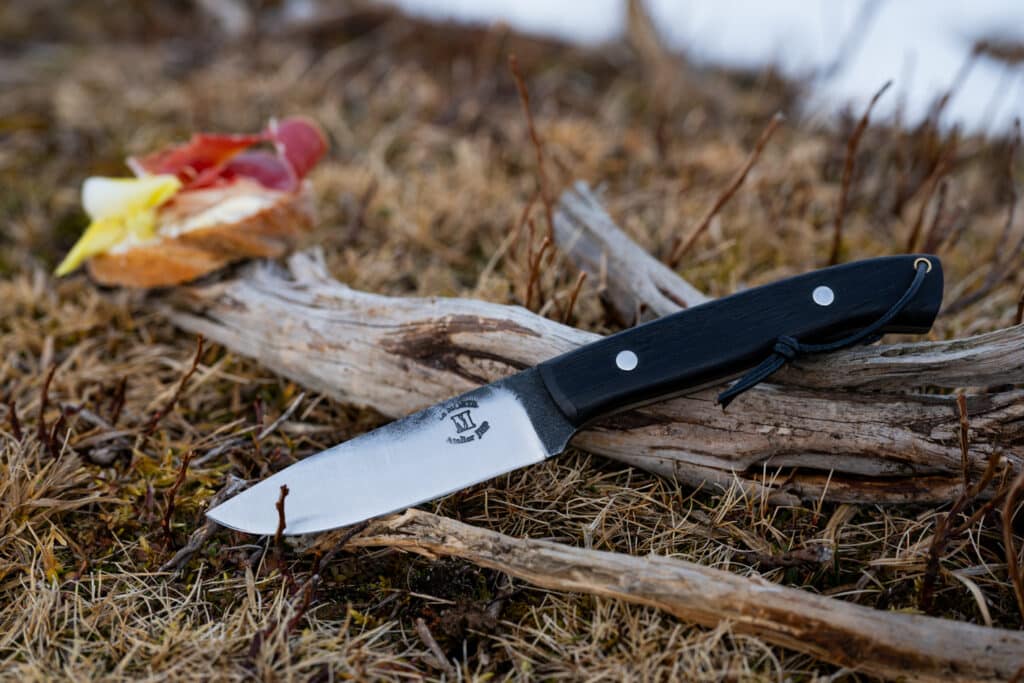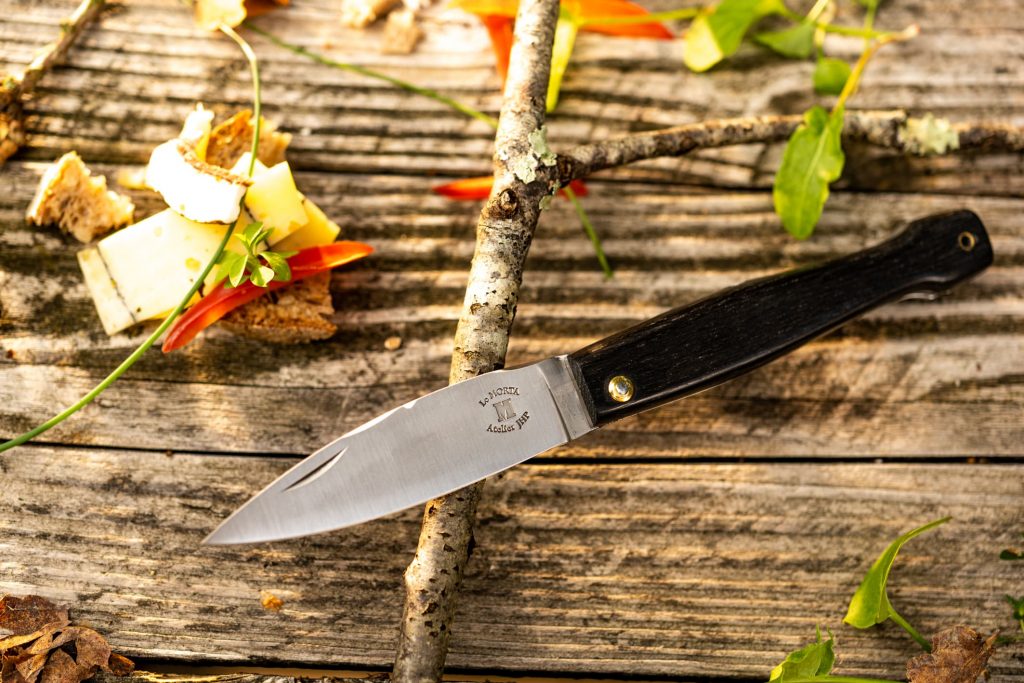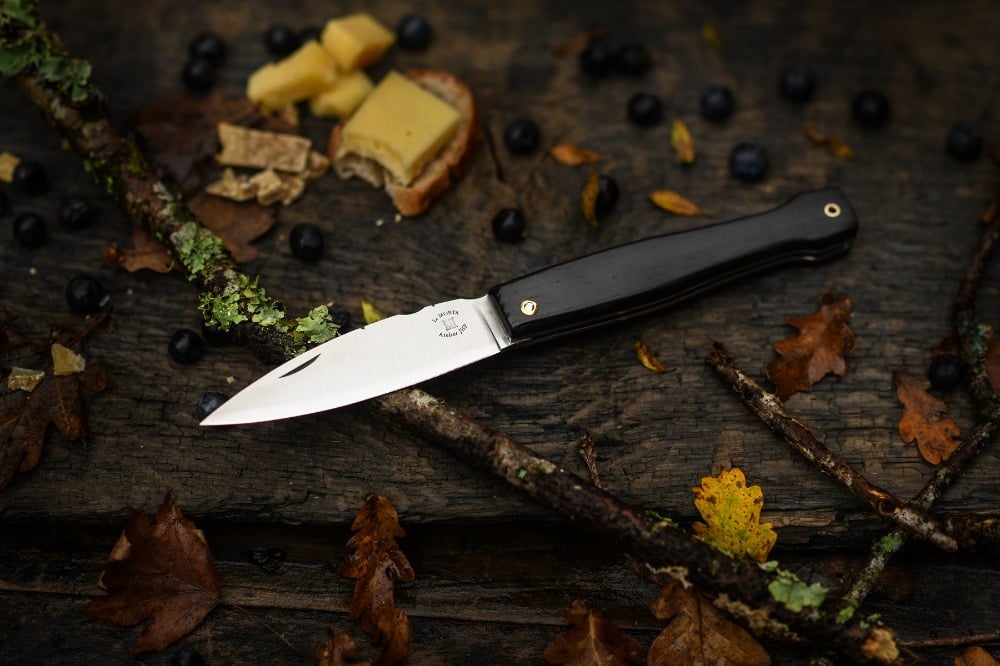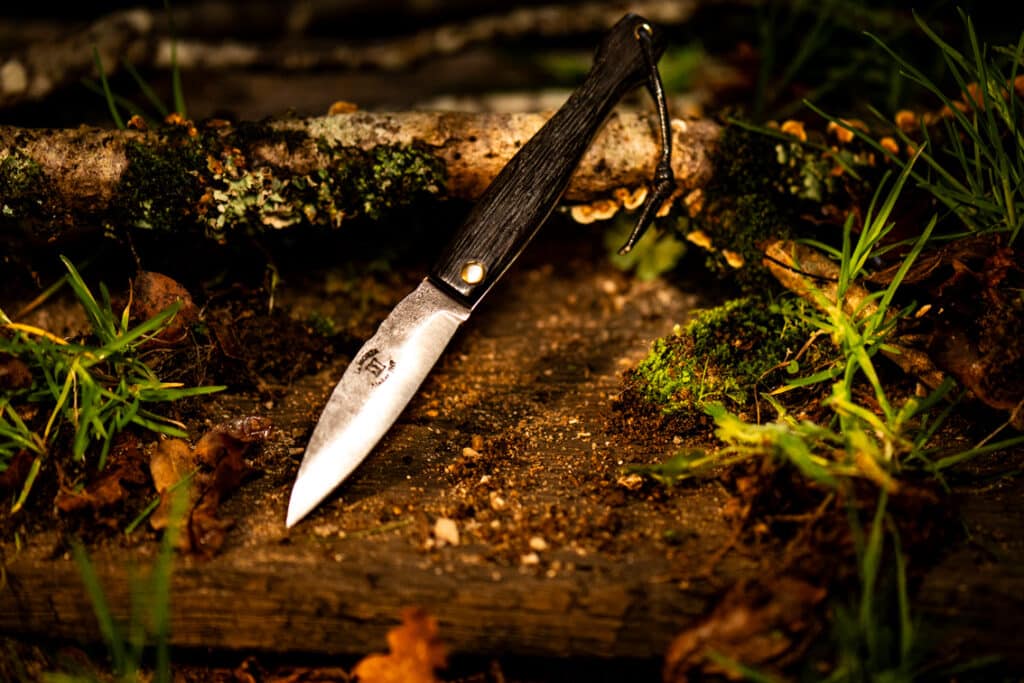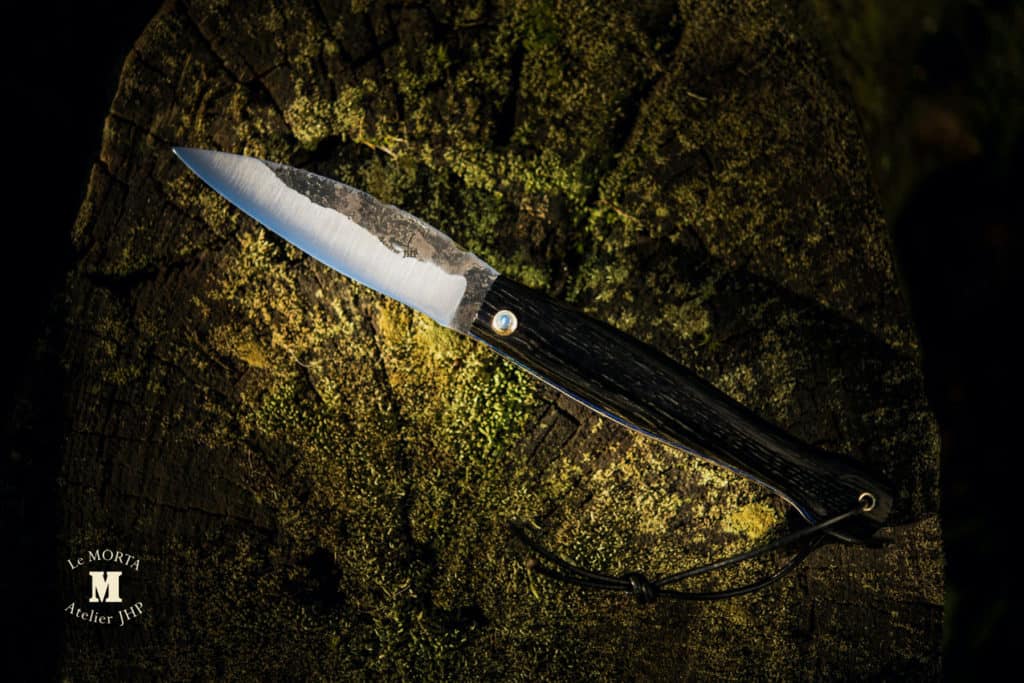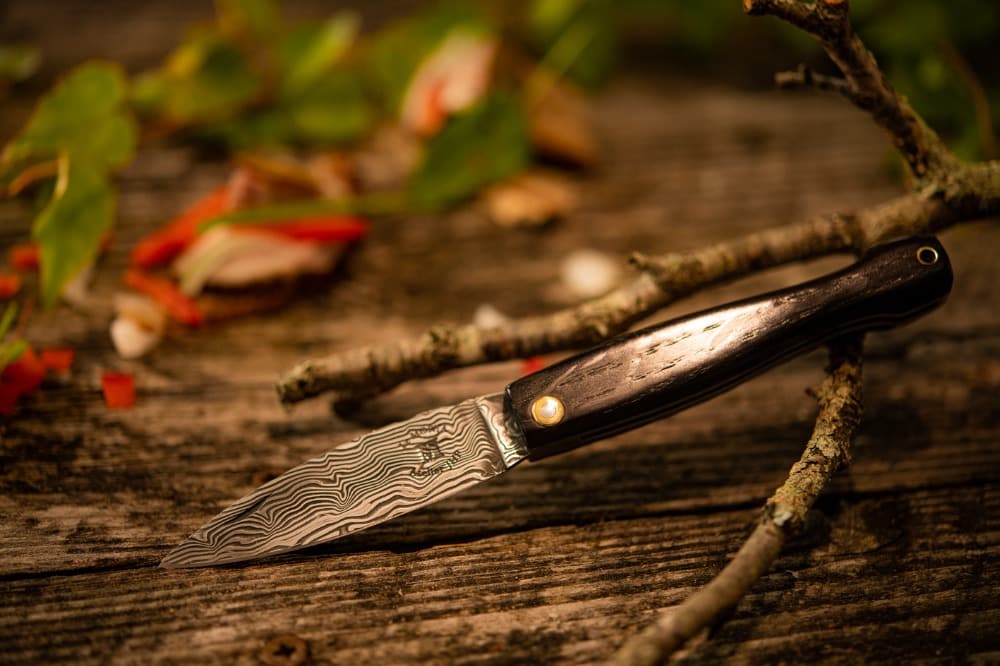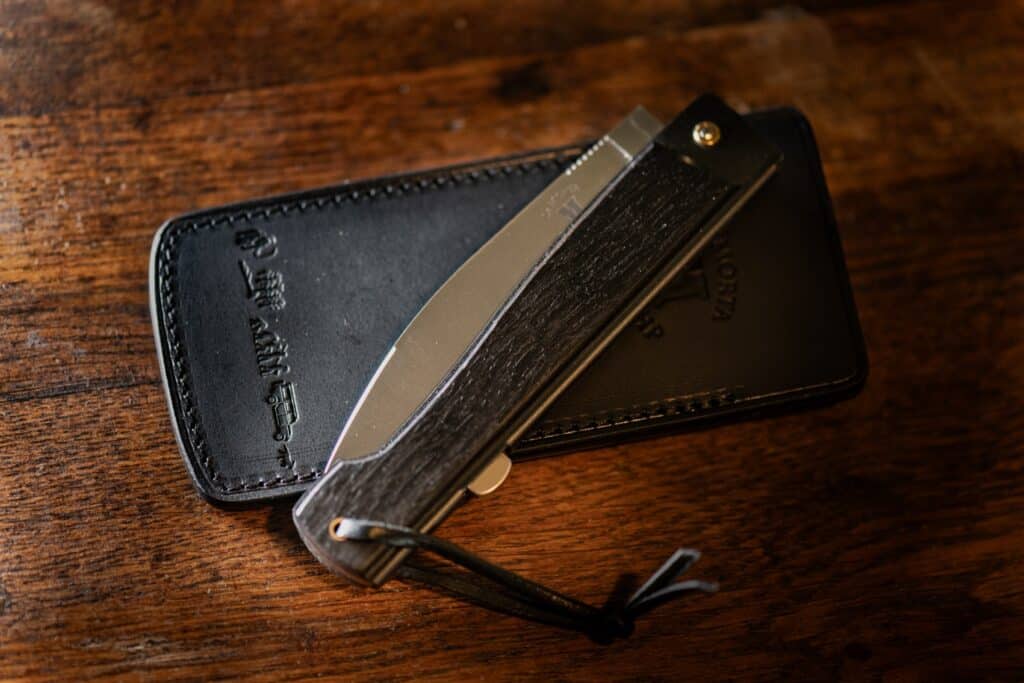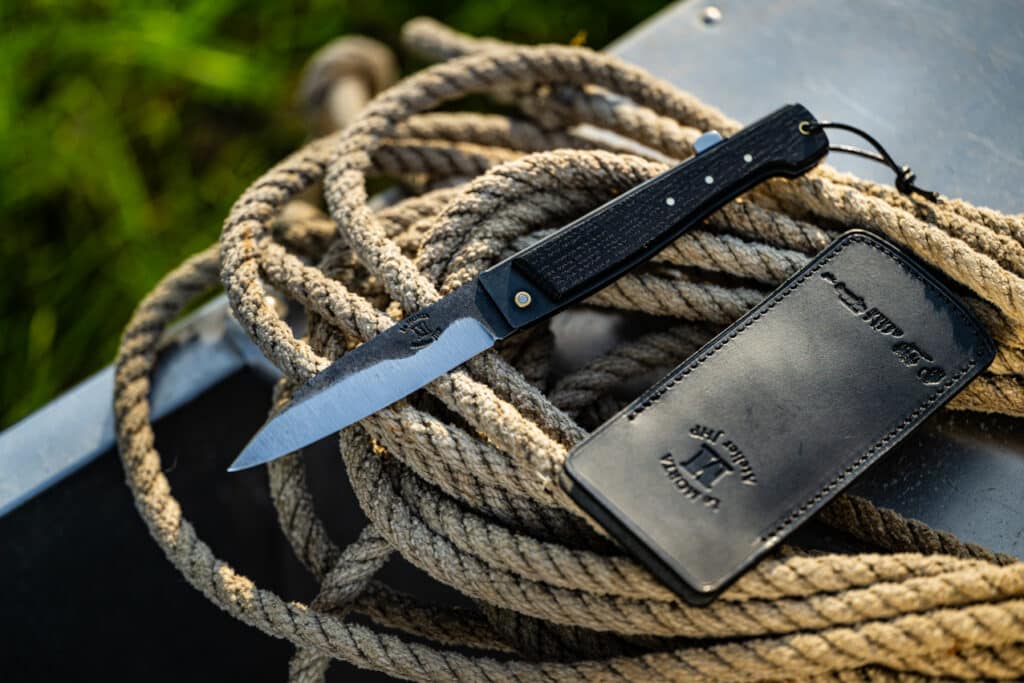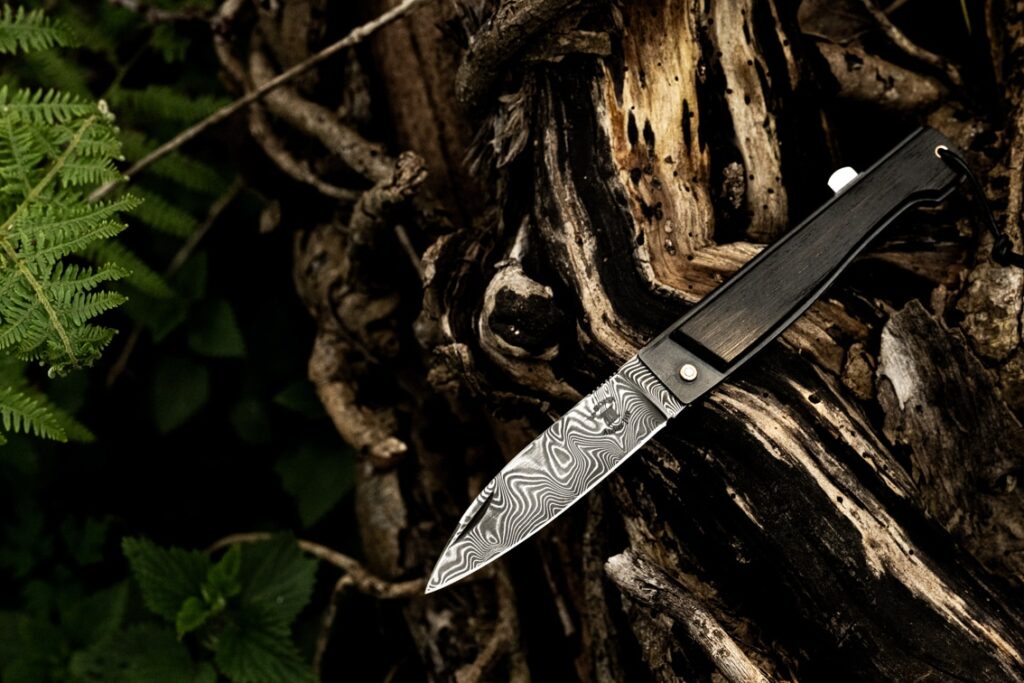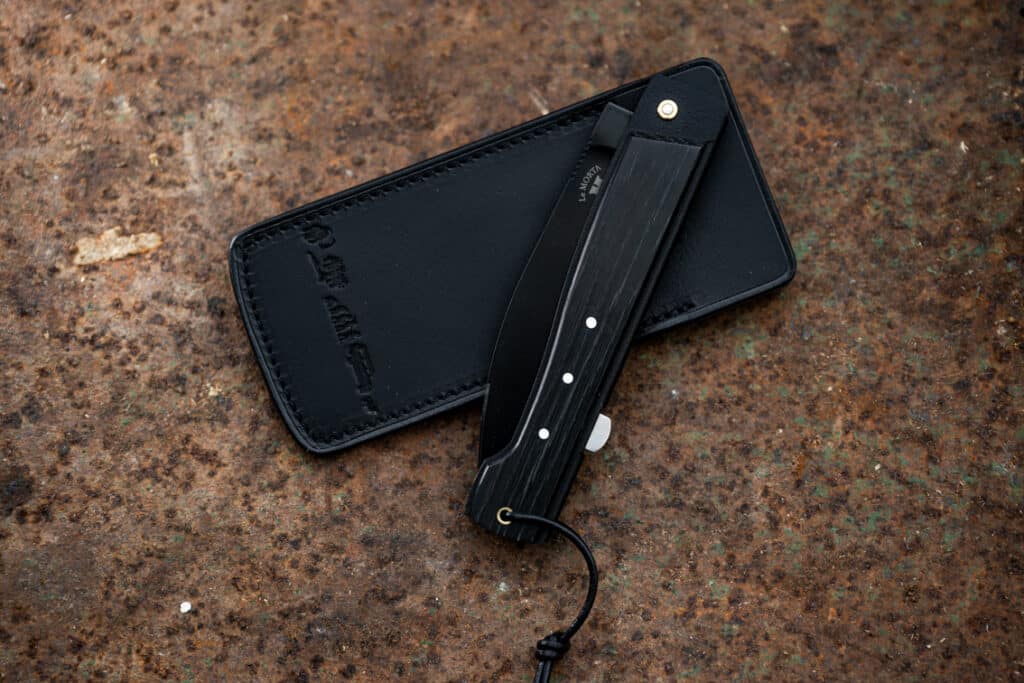The ground crunches underfoot. The pack is strapped on, the pace set, the breath steady. When hiking, every detail counts. The adventurer doesn’t choose his utensils, he selects his essentials. Walking shoes, compass, water bottle and knife. Whether fixed-blade or folding, it remains discreetly at hand. Tucked away in a pocket, it waits for the adventurer’s palm to grasp it before fulfilling its mission. To facilitate life in the wilderness and restore its primary function: connection with living things. Carving a branch, sculpting a spoon and, above all, slicing finely the smoked sausage chosen with relish before departure. As the experienced explorer confirms, if he had to equip himself with just one tool, it would be his hiking knife. This is where the excursion begins, to choose one with pleasure and conscience.
Hiking knife: how it differs from a camping knife
Long walks in the great outdoors are a delight for inveterate hikers. Filling your lungs with fresh, clean air is invigorating and rejuvenating. But if your backpack weighs a ton, or worse, if you need two backpacks to fit all your gear, hiking becomes a nightmare.
Hikers are looking for something light and functional. Hiking knives meet this demand for practicality. On the trail, a blade must cut, slice and peel without ever weighing you down.
Whereas a camping knife often stays in the tent, a hiking knife travels. So it’s handy and compact.
The versatile blade cuts quickly and safely.
The camper is busy setting up (preparing the shelter) and daily life (cooking for the family). The adventurer, on the other hand, has occasional needs. Meals become snacks, and construction work becomes repairs and repairs.
Like experienced hikers and bushcraft enthusiasts, sort out the tools you’ll need in your survival bag.
Why take a knife hiking?
A good hiking knife is more than just sharp. It has to be versatile, handy and always accessible, in your pack or pocket. It can be used to slice bread and cheese during a well-deserved picnic break. It can also be used to core an apple, open a tough wrapper or a gourd that’s a little too tight. Some walkers even use it to uncork a bottle.
Beyond snacking, a folding knife with a stainless blade quickly becomes indispensable for :
- cutting a strap ;
- trimming a walking stick ;
- clearing a branch ;
- clearing a trail;
- improvise an emergency bandage;
- sharpen a tent peg, because yes, a proper hike lasts several days;
- enjoy the simple fact of having a faithful partner along for the ride.
Finally, for more contemplative walkers, it becomes a tool for ritual: carving a souvenir into a branch or engraving an initial into the trunk of a tree.
🔪 Practical tip
Always keep your knife in an easily accessible pocket. Not at the bottom of your bag, unless you never intend to use it 😉.
Hiking knife or multi-purpose tool? Why a knife isn’t a gadget
After many hours (days?) on trails and through forests, every gram counts. When faced with multifunction tools, the experienced hiker wonders. While they may be useful in town or in a refuge, their complexity can quickly become a drawback on the long haul.
The sturdy, easy-to-use folding knife is the reliable choice. It cuts flawlessly, opens with a flick of the wrist and won’t let you down in the middle of the woods. Where a gadget struggles to keep up, a real hiking knife does the job, without fuss. Less bulky, more ergonomic, it’s there for all the key moments: cutting, slicing, trimming, securing.
🔪 Practical tip
For a multi-day hike with bivouac, opt for a quality main knife rather than a multiple, complicated item. You’ll gain in efficiency, safety and comfort.
Choosing the right model means avoiding false promises and focusing on what really counts: reliability, simplicity and durability. Here’s how.
How to choose your hiking knife?
Weight and bulk: two criteria for long walks
When hiking, every kilo of equipment is felt in the legs of the modern pilgrim. The “every gram counts” rule also applies to knives. A model that’s too heavy or bulky ends up at the bottom of the pack. A well-designed knife is always within easy reach (jeans or cargo pocket, top pocket of a hiking bag). That’s why an artisan knife maker pays so much attention to manufacturing details.
Folding knife or fixed knife? Both are suitable, depending on your intended use. If you opt for a fixed blade, store it in a sheath.
🔪 Practical tip: the vertical scabbard and horizontal sheath with clip clip onto your belt.
A good folding trekking knife offers the advantage of minimal bulk, without compromising on maneuverability. It’s ideal for general-purpose work.
Sturdier, fixed-blade knives are ideal for experienced adventurers or outings in difficult terrain.
The right balance? The Morta Trapper combines solidity, natural grip and versatility. A true trail companion.
Which steel for an effective outdoor blade?
On the blade side, stainless and carbon steels will follow you wherever you roam (bushcraft, hiking, camping or survival training). N690, Sandvik 14C28N or Damascus forged at the Morta workshop, all combine corrosion resistance, ease of sharpening, quality edge and cutting performance.
A blade length of 8 to 11 cm offers a good compromise between efficiency and size. Blade geometry should enable effortless slicing, trimming and cutting.
Good to know 😉
At Couteaux Morta :
- all steels offer a minimum hardness of 59 HRC on the Rockwell scale;
- Damascus steel is made from N690 steel and DE 45ncd16 steel. Its hardness is 61 HRC.
An ergonomic, durable handle
The handle, sometimes overlooked in the selection process, makes all the difference. In wet conditions, it must be ergonomic, comfortable even with gloves, and slip-resistant. Wood, horn, polymers or composites: it all depends on your sensitivity to beautiful things and authentic materials.
Morta, a fossilized wood several millennia old, offers incomparable strength and warmth in the hand. Organic material: a real plus for those who want to combine technicality and life.
Choosing a hiking knife is all about utility, durability… and enjoyment.
Techniques for using a knife when hiking: the essential gestures of the autonomous hiker
Mastering basic slicing techniques turns your pocket knife into a precious ally.
- For food cuts, always stabilize what you’re slicing: bread held against the thigh, sausage held on a makeshift board or flat stone.
- To carve wood, use the batoning process. Place your folding knife on the branch, and gently tap the back of the blade with a piece of hard wood. Your stainless steel blade will split cleanly without forcing.
- To carve a walking stick, use light, controlled strokes.
- Sharpen your blade regularly: a sharp knife requires less force and reduces the risk of accidents.
- To shape wood (stake points, utensils), cut away from your body, using short, controlled strokes. Hedgehog or “feather stick” cutting (fine shavings for lighting a fire) is done with the blade flat.
🔪 The golden rule: always cut away from your hand. Work on a stable surface, never in a vacuum.
The right gesture is the one that doesn’t hurt you.
Hiking and regulations: carrying your knife legally
In France, a hiking knife is legally considered a category D knife. Owning one is totally legal, just be aware that carrying and transporting it is subject to certain conditions. To remain in compliance with the law, all you need to do is provide proof of legitimate use.
Rest assured, preparing a meal on the trail, tinkering in the wilderness or chopping wood are all perfectly valid and acceptable reasons.
Be sure to adapt your behavior to the context: avoid taking out your blade in a public place if you don’t have anything to cut. And if you’re stopped, simply explain that you’re out hiking and show your equipment.
👉 To find out more, read our full article on knife use in France.
Walking with a Morta knife means walking through the centuries
The Morta, a journey through time
Have you been walking for hours? The Morta has spent 5,000 years in the peat. He knows nature. He’s an integral part of it. Its heart beats to the rhythm of sunrises and sunsets. A wood in the process of fossilization, it is carefully and rigorously extracted from the Brière soil. The time of year, the quota, the area: everything is regulated to respect the ecosystem and encourage the reproduction of flora and fauna.
Choosing Morta for the handle of your knife also means supporting French craftsmanship and manufacturing.
Between tradition and transmission
Discreetly tucked away in your pocket, your Morta knife accompanies you. You’re not alone on this path lost on the edge of the country. Like an echo of your ancestors’ gestures, it supports you and faces natural obstacles at your side. Perhaps one day your son or daughter will take these same country roads. That day, with the sun at its zenith, he or she will rest in the shelter of an oak tree, take out the baguette bought in the morning from the village baker and slice it with that same Morta knife.
This knife could well become your heirloom. There are several ways to personalize it:
- engrave a first name, a proverb or a word in 5 different fonts;
- reproduce an identical handwritten message;
- inscribe your association or company logo, or the family coat-of-arms;
- add 3 mini mammoth ivory inlays;
- insert a blue vulcanized border.
When hiking, we don’t talk much. But this one speaks volumes.

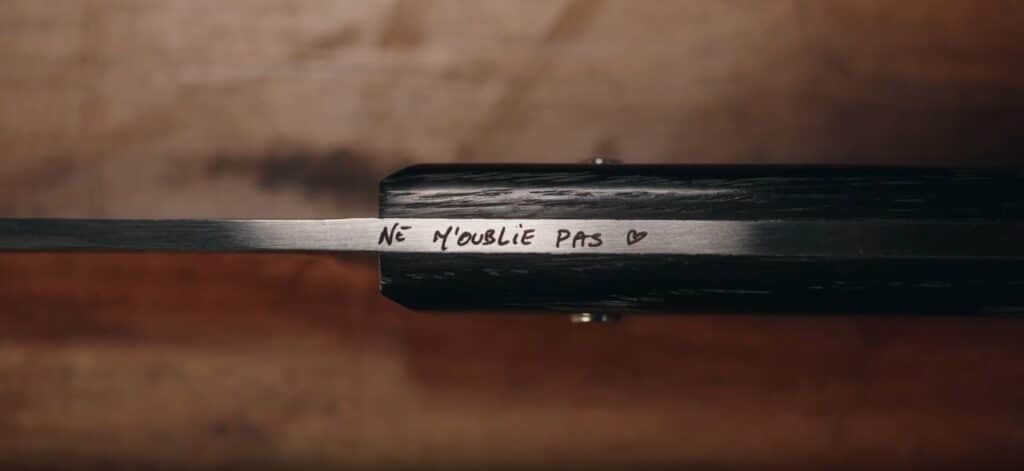
We often go hiking to get away from the noise. In the fresh air, landmarks change. Life slows down. In this new-found simplicity, certain objects come into their own. A good hiking knife isn’t just big, it’s small. It doesn’t clutter up the gesture or the mind. It’s there when you need it, unobtrusive the rest of the time.
Morta tells a story, linking the past to the present and preparing for the future. Neither a gadget nor a provocation. Just a tool to match your walk: sober, reliable, alive.
Article written by Christelle Lorant 🪶
The article’s key questions
What distinguishes a hiking knife from a camping knife?
A hiker’s knife is lightweight and compact, while a camper’s knife is sturdy. A camping knife is often kept in the tent for set-up work and family cooking. A hiking pocket knife, on the other hand, travels in the hiker’s pocket!
On the trail, your needs change: meals become snacks, construction becomes occasional repairs. Your multi-purpose stainless steel blade will cut, slice and peel without ever weighing you down.
The hiking knife is your unobtrusive, hard-wearing partner, ready to fulfill its mission: facilitating activities in the great outdoors. Also for cooking, chopping firewood and, above all, slicing that smoked sausage! The experienced explorer confirms: if he had to equip himself with just one tool, it would be his folding knife.
What are the advantages of folding pocket knives for hiking?
Folding pocket knives are ideal for storage and transport! A lightweight pocket knife with an internal safety catch and stainless steel for sharpness becomes your best ally.
Easy to carry, they slip discreetly into your pocket without risk of injury. Lightweight, compact models won’t weigh you down during hours of walking. The safety catch guarantees secure opening, even with wet gloves.
Suitable for precision trimming and cutting, they meet all your needs, whether you’re cooking or tinkering in the great outdoors. Don’t forget the protective case to optimize your companion’s storage. Because if your bag weighs a ton, hiking becomes a nightmare! A well-chosen folding knife means freedom on the trail.
Why choose a knife over a multi-tool for hiking?
Ah, the gadget trap! After several hours on the trail, every gram counts. Multifunctional tools can help you out in town or in a refuge, but their complexity quickly becomes a drawback over the long haul.
A sturdy folding knife is the reliable choice. It cuts flawlessly, opens with a flick of the wrist and won’t let you down in the middle of the woods. Where a gadget struggles to keep up, a real hiking knife does the job, without fuss.
For multi-day hikes and bivouacs, opt for a quality main knife rather than a complicated multi-purpose item. You’ll gain in efficiency, safety and comfort. Less cumbersome, more ergonomic, it’s there for the key moments: cutting, slicing, carving, securing.
What are the essential criteria for choosing my hiking knife?
When you’re hiking, every kilo counts in your legs! The “every gram counts” rule also applies to knives. A knife that’s too heavy will end up at the bottom of your pack, whereas when you’re hiking, it should stay in your hand.
- So opt for lightweight, compact rando knives. Folding or fixed knife? Both are suitable, depending on your use. To store and transport a fixed knife, consider the vertical sheath or horizontal sheath with belt clip.
- Our stainless steels (N690, Sandvik 14C28N) and carbon steels combine corrosion resistance and sharpness.
- Ideal length: 8 to 11 cm, a good compromise between efficiency and size. Suitable for precision trimming and cutting.
- In wet conditions, they must remain safe even when wearing gloves. Morta, an age-old wood, offers incomparable warmth.
- Think of sharpening to maintain the edge, and engraving to personalize your companion. The Morta Trappeur combines solidity, natural grip and bushcraft versatility. When choosing a hiking knife, think utility, durability… and enjoyment!
How do I use my knife correctly when hiking?
Mastering the essential gestures turns your pocket knife into a precious ally! When cutting food: always stabilize what you’re slicing.
To carve wood, use a fixed knife: place your knife on the branch, and gently strike the back of the blade with a hardwood. Your stainless steel blade will split cleanly without forcing.
Carving a stick? Light, controlled strokes. Cutting fine chips for fire is done with the blade flat. Sharpen regularly: a sharp knife requires less force and reduces accidents.
The golden rule: always cut away from your hand, on a stable surface, never in a vacuum. The right move is the one that doesn’t hurt you!
Can I legally carry my hiking knife?
Don’t worry! In France, carrying a hiking knife is totally legal. All you need to do is justify its legitimate use. Preparing a meal on the trail, tinkering in the wilderness or chopping wood are all perfectly valid reasons.
Legally, your knife is a category D stabbing weapon, but you can carry it with justification. Adapt your behavior to the context: avoid taking out your blade in a public place if you have nothing to cut.
If you are stopped, simply explain that you are out hiking and show them your equipment. Law enforcement agencies understand this outdoor use perfectly well.
Morta accompanies you on your adventures! With 5,000 years in the peat of the Brière region, this fossilizing wood knows nature better than anyone. Choosing Morta means carrying a fragment of history, a legacy to be passed on to future generations. Neither gadget nor provocation: just a tool to match your walk, sober, reliable and alive.


